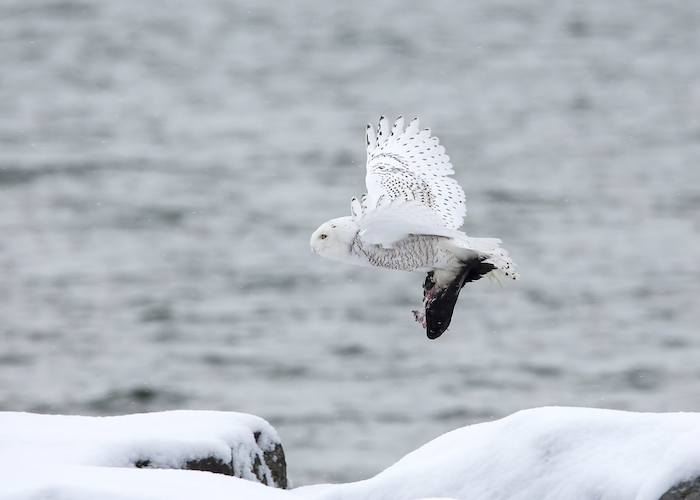This page tells about the Snowy Owl. It includes a video. It is part of our Arctic Wildlife series.
Description
The magnificent Snowy Owl is the world's heaviest owl. Measuring up to 28 inches in length, the adult is pure white with large yellow eyes and occasional specks of black on the wings and tail. The feet are feathered to the talons. Immature Snowy Owls show numerous black or brown markings on the head, underparts, back, and wings. Males and females are similar, though females usually show more of the dark markings. Largely diurnal rather than nocturnal, Snowy Owls often wait on prominent perches such as hills, snow banks, fenceposts, or telephone poles, patiently waiting to ambush prey. Snowy Owls rarely perch on trees.
Diet
The Snowy Owl is heavily dependent on the lemming, a small, Arctic rodent. The owl may eat five lemmings per day! The Snowy Owl will also take rabbits, ducks, waterfowl, and occasionally fish.

Snowy Owl with Prey
Range and Habitat
The Snowy Owl breeds in the high Arctic tundra of Alaska, Canada, Greenland, and Eurasia. In the winter, individuals may migrate south in search of food. Although its normal wintering range extends no farther south than southern Canada and the northern United States, immature birds may wander farther south into the central United States when supplies of prey are low. Perhaps no other North American bird mobilizes the avid birdwatcher than the Snowy Owl. Reports of Snowy Owl sightings in the winter often attract hundreds of birdwatchers. Snowy Owls often allow close approach and perch in conspicuous places which makes photographing the birds relatively easy. Snowy owls breed in the Arctic tundra. In migration they prefer open country, beaches, marshes, airports, farms.
Status
Populations of Snowy Owls seem stable, though they are certainly not classified as common.
Related activities
Advertisement

